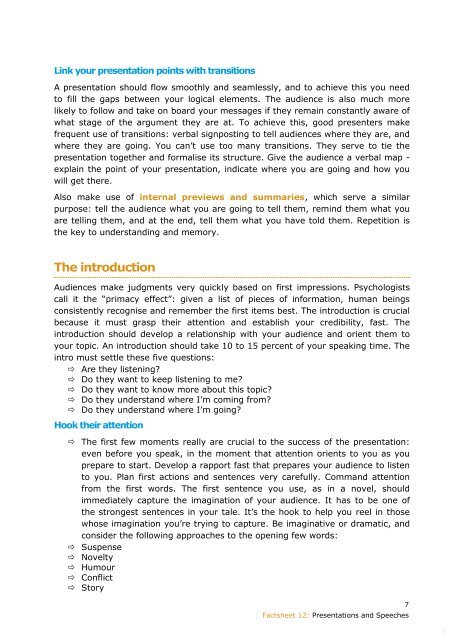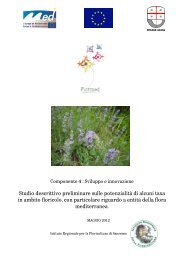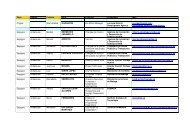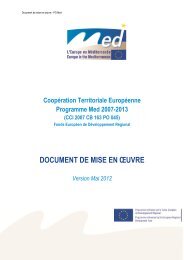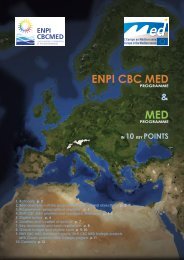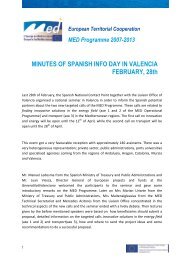MED Communication Handbook - Programme Med
MED Communication Handbook - Programme Med
MED Communication Handbook - Programme Med
You also want an ePaper? Increase the reach of your titles
YUMPU automatically turns print PDFs into web optimized ePapers that Google loves.
Link your presentation points with transitions<br />
A presentation should flow smoothly and seamlessly, and to achieve this you need<br />
to fill the gaps between your logical elements. The audience is also much more<br />
likely to follow and take on board your messages if they remain constantly aware of<br />
what stage of the argument they are at. To achieve this, good presenters make<br />
frequent use of transitions: verbal signposting to tell audiences where they are, and<br />
where they are going. You can’t use too many transitions. They serve to tie the<br />
presentation together and formalise its structure. Give the audience a verbal map -<br />
explain the point of your presentation, indicate where you are going and how you<br />
will get there.<br />
Also make use of internal previews and summaries, which serve a similar<br />
purpose: tell the audience what you are going to tell them, remind them what you<br />
are telling them, and at the end, tell them what you have told them. Repetition is<br />
the key to understanding and memory.<br />
The introduction<br />
Audiences make judgments very quickly based on first impressions. Psychologists<br />
call it the “primacy effect”: given a list of pieces of information, human beings<br />
consistently recognise and remember the first items best. The introduction is crucial<br />
because it must grasp their attention and establish your credibility, fast. The<br />
introduction should develop a relationship with your audience and orient them to<br />
your topic. An introduction should take 10 to 15 percent of your speaking time. The<br />
intro must settle these five questions:<br />
� Are they listening?<br />
� Do they want to keep listening to me?<br />
� Do they want to know more about this topic?<br />
� Do they understand where I’m coming from?<br />
� Do they understand where I’m going?<br />
Hook their attention<br />
� The first few moments really are crucial to the success of the presentation:<br />
even before you speak, in the moment that attention orients to you as you<br />
prepare to start. Develop a rapport fast that prepares your audience to listen<br />
to you. Plan first actions and sentences very carefully. Command attention<br />
from the first words. The first sentence you use, as in a novel, should<br />
immediately capture the imagination of your audience. It has to be one of<br />
the strongest sentences in your tale. It’s the hook to help you reel in those<br />
whose imagination you’re trying to capture. Be imaginative or dramatic, and<br />
consider the following approaches to the opening few words:<br />
� Suspense<br />
� Novelty<br />
� Humour<br />
� Conflict<br />
� Story<br />
� Factsheet 12: Presentations and Speeches<br />
7<br />
�


